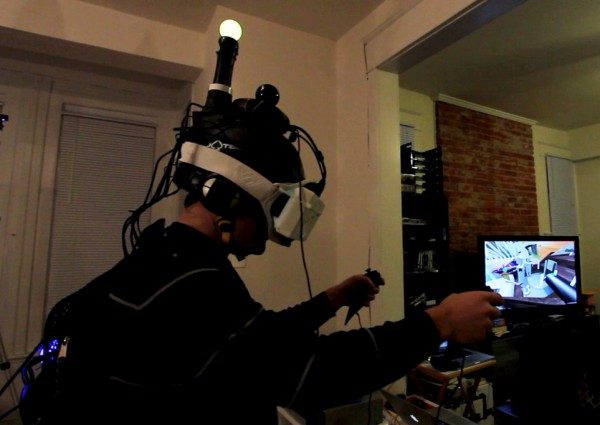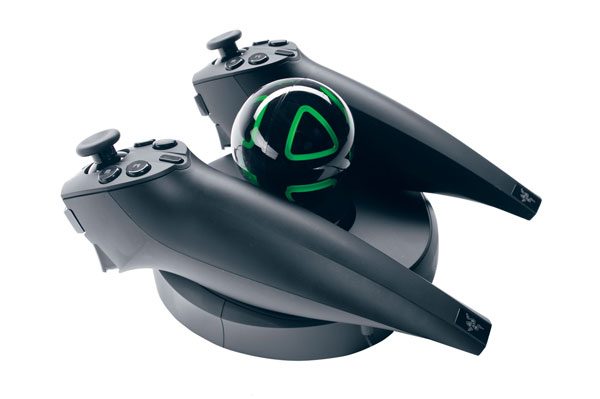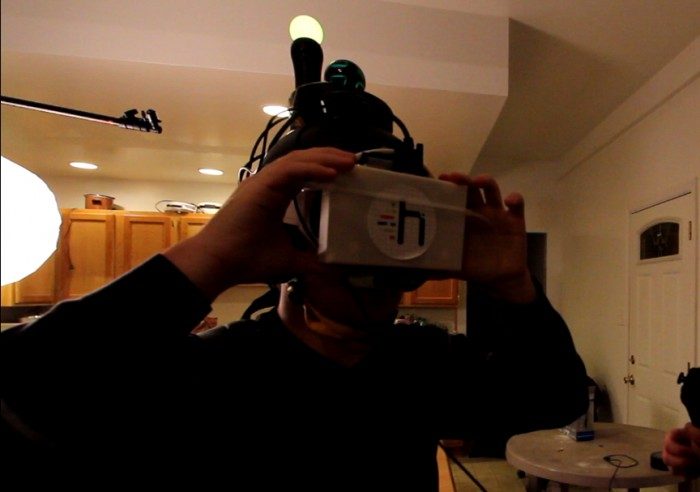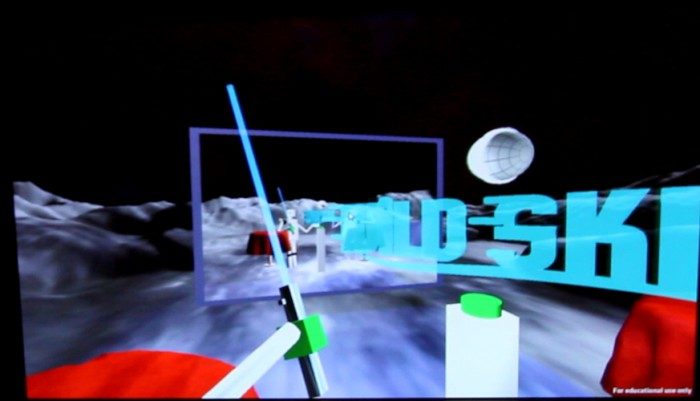Recently I got a chance to meet up with Project Holodeck director Nathan Burba. Not only did we sit down for a detailed interview, but I was also fortunate enough to get a hands-on demo of the system. Project Holodeck is an immersive virtual reality multiplayer platform. Yes, that’s a mouthful, but it means something significant. This is a complete virtual reality platform. The Oculus Rift is great, and I can’t wait to get my hands on it, but I’m even more excited for Project Holodeck because it is the complete virtual reality package.
Project Holodeck, which will actually be using the Oculus Rift once it’s available, is more than just a head mounted display (VR headset). It is a fully immersive platform that provides avatar embodiment – the sense of literally stepping into the game world (with more than just your head). Instead of controlling your character in the Holodeck with a controller, you simply are the character; you walk, reach, grab, and look around the world just like you would in real life. The system tracks your movements in 6-degrees of freedom which means you are free to walk, jump, crouch, and lean and it will be faithfully represented in the game world.

Project Holodeck is still a ways from completion. But the team, working out of USC, has put together something very promising.
Inside of Project Holodeck
I did my best to show what it felt like to be inside Project Holodeck, but I know the video can’t quite convey that.
While the Socket HMD (VR headset) really helped suck me into the world, it was the natural interaction with the environment that blew me away and made me realize that gaming as we know it is about to change in a big way.
Realism vs. Immersion
The graphics of the game are very much alpha — everything is placeholder. Despite that, I felt very immersed. There’s an important distinction to be drawn between realism and immersion. Realism could be described as being so realistic that you can’t separate what’s real from what’s fake. Immersion, on the other hand, is interacting so naturally with a virtual world that responds like you would expect it to in real life. I realize these aren’t the best definitions, but just understand that you can be immersed without mistaking the virtual world for the real world.
I didn’t mistake the inside of Project Holodeck for reality, but I was so immersed that at one point I needed to set the Razer Hydra controllers down to adjust my helmet and I nearly tried to set them down on a virtual table next to me. There was no table in real life — had I not quickly realized what I was about to do, I would have dropped the controllers straight onto the floor below. I laughed at myself after realizing my mistake, but it really drove home how much I felt like I was inside of the game.
Navigating around the world by physically walking to where you want to go simply can’t be beaten by other methods of input (and it is 100x better than running in place like an idiot in front of a Kinect). I was impressed that they managed to get a 2-player 20×20 space with just one PlayStation Eye camera and two sets of PlayStation Moves.
Razer Hydra
 Then there’s the Razer Hydra which worked even better than I had anticipated. With a controller in each hand, you reach out and touch objects rather than using some incarnation of ‘press X to hold’. You see your arms hands in front of you right where you expect them to be. Want to grab the cannon on the side of the ship? Walk up to it, reach out your arms, and grab the handles. Though the ‘grabbing’ part was still technically done with a button on the Hydra, it was far more natural because your hand has to be right next to the object that you want to grab.
Then there’s the Razer Hydra which worked even better than I had anticipated. With a controller in each hand, you reach out and touch objects rather than using some incarnation of ‘press X to hold’. You see your arms hands in front of you right where you expect them to be. Want to grab the cannon on the side of the ship? Walk up to it, reach out your arms, and grab the handles. Though the ‘grabbing’ part was still technically done with a button on the Hydra, it was far more natural because your hand has to be right next to the object that you want to grab.
From my brief time in the Holodeck, the fidelity felt like it was to the point that you could sit down to a virtual dinner table and easily grab the salad fork without accidentally grabbing the adjacent dinner fork. I’m looking forward to when something like the Razer Hydra turns into a glove-like peripheral where you do indeed just clench your hand to initiate the grab.
Swords and Guns
One neat experience inside the Holodeck was grabbing the swords from your back. You literally reach over your head and behind your back and grab them… pull your arms forward and now you’re wielding two swords. It’s like your 5 year-old imagination come true. In the Holodeck there were also pistols on your thighs which you could grab and fire. It was also possible to take a sword or pistol off of your compatriot which could lend itself to some interesting gameplay if you happen to drop your sword or gun overboard.
So far there aren’t any enemies at which to swing your swords or shoot your guns, though the act of just wielding them was surprisingly entertaining… especially the lightsabers we got to use in the pre-game environment. Enemy ships were the only hostiles I saw in the game, and they could be destroyed with the cannons on the side of the ship.
Airship
In the game you are on an airship which is flying through the world. There was about a 20×20 foot space to walk around on the deck. Each side had a cannon. There was a circular glass pane in the floor which let you see below the ship to drop bombs. At the front of the ship was the helm which was a virtual flight-yolk that you could reach out and control.
Flying around was a bit jarring because the ship could roll and pitch at severe angles, rendering the world sideways from your perspective — as though you were standing on an impossible incline. Things felt somewhat off without the corresponding input from my inner-ear telling me that the ship is rolling. It didn’t make me sick, but it was visually disorienting. Removing the ability for the ship to roll and pitch might make for a better virtual reality experience.
Socket Head Mounted Display (VR Headset)
The Socket HMD that the game currently uses will be replaced as soon as the Oculus Rift is available. When the project started, Palmer Luckey (creator of the Oculus Rift) was the lead hardware engineer for the project. Since then, he’s now moved to what Project Holodeck Director Nathan Burba called a ‘hardware adviser’ role. Long story short — Luckey has a lot on his hands with the Oculus Rift, though he’s helping the Project Holodeck team with head mounted displays.
Currently the team is using the Socket HMD from the MxR Lab at USC. The unit is very similar in design to the Oculus Rift. It has a 3D printed case, uses a split 5-inch display with 800×640 resolution — the same resolution as the forthcoming Oculus Rift developer kit (it may even be the same display that early Rift prototypes have been using). The field of view is around 90 degrees horizontally (even more vertically) and naturally it’s 3D.
After putting on the Socket VR headset you no longer feel like you’re standing in a room. Your field of view is completely taken over by the display. There is some level of peripheral vision that is technically not taken up by the display — after all we have around a 180 degree field of view — but it is completely dark. Your mind focuses only on what’s ‘in front’ of you, which is the game world, and blocks everything else out quite effectively.
Before we jumped into the game Wild Skies, we stood on the moon in a pre-game environment. Above me was an expanse of stars and in front of me was a mirror where I could see my virtual avatar. Then we jumped into Wild Skies and flew around a bright world. The resolution of the Socket and forthcoming Oculus Rift is indeed low (800×640), but it didn’t hamper the experience too much. Even though I’m typically a stickler when it comes to resolution, the natural interactions and proper headtracking overpowered any low-res complaints. When I was looking for it I did notice some ghosting when turning my head (due to slow response time on the display), but it didn’t harm the experience too much (and the Oculus Rift developer kit should have a much improved response time).
When I took the Socket off it really felt like I was coming back from somewhere else. A minute ago I was flying around a bright world on an airship, and suddenly I’m back in a dimly lit room. It really drove home the immersion.
That’s enough from me for now. I’m sure there are some things I’ve missed. Feel free to drop me a line in the comments; I’ll be happy to answer any questions.
You can follow the progress of Project Holodeck at the official website: http://www.ProjectHolodeck.com








